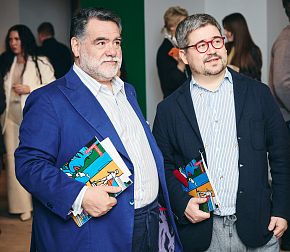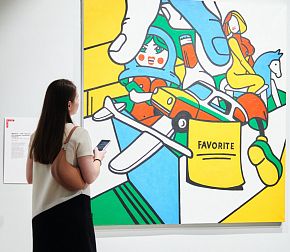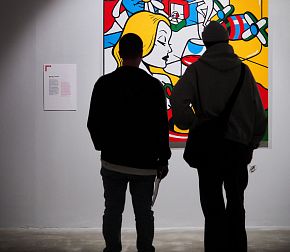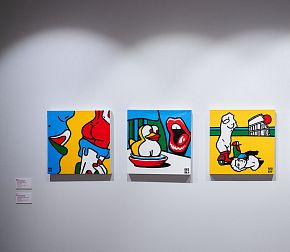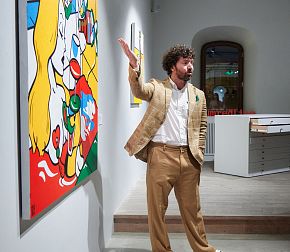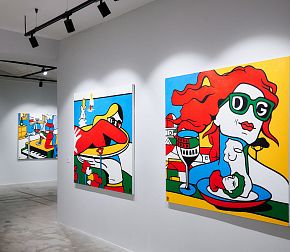All news
Latest News
The GUM-Red-Line Gallery presents Roman Reznitsky’s personal exhibition “Immodest Charm,” which presents paintings fr om recent years. Reznitsky works in Russia and abroad. His practice is based on the idea of combining fine and popular culture, developing the image of a contemporary artist as a brand, and an interest in collaborations. His visual language is greatly influenced by his long experience in graphic design and marketing. >
The exhibition mainly consists of large square canvases, a significant part of which is executed in the expressive means of pop art. The plots are collected from images of popular culture, phenomena of everyday life and personal symbols of the author. In many ways, they represent thematic puzzles, wh ere everything is not just like that: shadows form into the faces of lovers, a road zebra crossing into an ancient colonnade, and steam from coffee into an air kiss. Despite the similarities with pop art, Reznitsky does not use stencils or printing techniques, but creates works with a brush and thick paint. Based on advertising aesthetics, the author works with a fixed set of pure colors, turns to combinatorial techniques, and experiments with composition and scale.
A special place is occupied by works in the dot art technique. This is an adapted legacy of pointillism, in which the image consists of many small dots. However, for the modern viewer, optical dot art rather repeats the principle of raster printing: this effect of city banners, which upon close examination turn out to be a set of chaotic round strokes, is familiar to everyone. In dot art works, Reznitsky abandons color and is keen on conveying depth and volume using tone; it varies by compacting the mass of dots or, conversely, increasing spaces. The characters in this series are the so-called ideal women, their bodies and facial features. Among them one can discern the Mona Lisa and the sexualized heroines of social networks. Thus, one cannot help but notice that the sphere of bodily culture is subject to constant changes in taste. The once lofty concept of beauty has long moved into popular culture and is being transformed to suit the needs of a wide audience. Like the major authors of pop art, Reznitsky simultaneously accurately describes and gently parodies familiar reality. On the one hand, these are impersonal examples of consumer culture, on the other, exaggerated pictures and staged situations. The works evoke a joy of recognition that is valuable for the viewer - in them it is easy to discern elements of the surrounding material world. However, behind each canvas there is a personal story that the author wants to share: “My goal is that in 100 years, from my paintings, people can draw a conclusion about what was happening in our society.”
Project curator An Kubanova
The exhibition runs until April 7. Admission is free.
The exhibition mainly consists of large square canvases, a significant part of which is executed in the expressive means of pop art. The plots are collected from images of popular culture, phenomena of everyday life and personal symbols of the author. In many ways, they represent thematic puzzles, wh ere everything is not just like that: shadows form into the faces of lovers, a road zebra crossing into an ancient colonnade, and steam from coffee into an air kiss. Despite the similarities with pop art, Reznitsky does not use stencils or printing techniques, but creates works with a brush and thick paint. Based on advertising aesthetics, the author works with a fixed set of pure colors, turns to combinatorial techniques, and experiments with composition and scale.
A special place is occupied by works in the dot art technique. This is an adapted legacy of pointillism, in which the image consists of many small dots. However, for the modern viewer, optical dot art rather repeats the principle of raster printing: this effect of city banners, which upon close examination turn out to be a set of chaotic round strokes, is familiar to everyone. In dot art works, Reznitsky abandons color and is keen on conveying depth and volume using tone; it varies by compacting the mass of dots or, conversely, increasing spaces. The characters in this series are the so-called ideal women, their bodies and facial features. Among them one can discern the Mona Lisa and the sexualized heroines of social networks. Thus, one cannot help but notice that the sphere of bodily culture is subject to constant changes in taste. The once lofty concept of beauty has long moved into popular culture and is being transformed to suit the needs of a wide audience. Like the major authors of pop art, Reznitsky simultaneously accurately describes and gently parodies familiar reality. On the one hand, these are impersonal examples of consumer culture, on the other, exaggerated pictures and staged situations. The works evoke a joy of recognition that is valuable for the viewer - in them it is easy to discern elements of the surrounding material world. However, behind each canvas there is a personal story that the author wants to share: “My goal is that in 100 years, from my paintings, people can draw a conclusion about what was happening in our society.”
Project curator An Kubanova
The exhibition runs until April 7. Admission is free.
28 february
Exhibition of Roman Reznitsky “Immodest Charm” at GUM-Red-Line
The GUM-Red-Line Gallery presents Roman Reznitsky’s personal exhibition “Immodest Charm,” which presents paintings fr om recent years. Reznitsky works in Russia and abroad. His practice is based on the idea of combining fine and popular culture, developing the image of a contemporary artist as a brand, and an interest in collaborations. His visual language is greatly influenced by his long experience in graphic design and marketing. >
The exhibition mainly consists of large square canvases, a significant part of which is executed in the expressive means of pop art. The plots are collected from images of popular culture, phenomena of everyday life and personal symbols of the author. In many ways, they represent thematic puzzles, wh ere everything is not just like that: shadows form into the faces of lovers, a road zebra crossing into an ancient colonnade, and steam from coffee into an air kiss. Despite the similarities with pop art, Reznitsky does not use stencils or printing techniques, but creates works with a brush and thick paint. Based on advertising aesthetics, the author works with a fixed set of pure colors, turns to combinatorial techniques, and experiments with composition and scale.
A special place is occupied by works in the dot art technique. This is an adapted legacy of pointillism, in which the image consists of many small dots. However, for the modern viewer, optical dot art rather repeats the principle of raster printing: this effect of city banners, which upon close examination turn out to be a set of chaotic round strokes, is familiar to everyone. In dot art works, Reznitsky abandons color and is keen on conveying depth and volume using tone; it varies by compacting the mass of dots or, conversely, increasing spaces. The characters in this series are the so-called ideal women, their bodies and facial features. Among them one can discern the Mona Lisa and the sexualized heroines of social networks. Thus, one cannot help but notice that the sphere of bodily culture is subject to constant changes in taste. The once lofty concept of beauty has long moved into popular culture and is being transformed to suit the needs of a wide audience. Like the major authors of pop art, Reznitsky simultaneously accurately describes and gently parodies familiar reality. On the one hand, these are impersonal examples of consumer culture, on the other, exaggerated pictures and staged situations. The works evoke a joy of recognition that is valuable for the viewer - in them it is easy to discern elements of the surrounding material world. However, behind each canvas there is a personal story that the author wants to share: “My goal is that in 100 years, from my paintings, people can draw a conclusion about what was happening in our society.”
Project curator An Kubanova
The exhibition runs until April 7. Admission is free.
The exhibition mainly consists of large square canvases, a significant part of which is executed in the expressive means of pop art. The plots are collected from images of popular culture, phenomena of everyday life and personal symbols of the author. In many ways, they represent thematic puzzles, wh ere everything is not just like that: shadows form into the faces of lovers, a road zebra crossing into an ancient colonnade, and steam from coffee into an air kiss. Despite the similarities with pop art, Reznitsky does not use stencils or printing techniques, but creates works with a brush and thick paint. Based on advertising aesthetics, the author works with a fixed set of pure colors, turns to combinatorial techniques, and experiments with composition and scale.
A special place is occupied by works in the dot art technique. This is an adapted legacy of pointillism, in which the image consists of many small dots. However, for the modern viewer, optical dot art rather repeats the principle of raster printing: this effect of city banners, which upon close examination turn out to be a set of chaotic round strokes, is familiar to everyone. In dot art works, Reznitsky abandons color and is keen on conveying depth and volume using tone; it varies by compacting the mass of dots or, conversely, increasing spaces. The characters in this series are the so-called ideal women, their bodies and facial features. Among them one can discern the Mona Lisa and the sexualized heroines of social networks. Thus, one cannot help but notice that the sphere of bodily culture is subject to constant changes in taste. The once lofty concept of beauty has long moved into popular culture and is being transformed to suit the needs of a wide audience. Like the major authors of pop art, Reznitsky simultaneously accurately describes and gently parodies familiar reality. On the one hand, these are impersonal examples of consumer culture, on the other, exaggerated pictures and staged situations. The works evoke a joy of recognition that is valuable for the viewer - in them it is easy to discern elements of the surrounding material world. However, behind each canvas there is a personal story that the author wants to share: “My goal is that in 100 years, from my paintings, people can draw a conclusion about what was happening in our society.”
Project curator An Kubanova
The exhibition runs until April 7. Admission is free.


